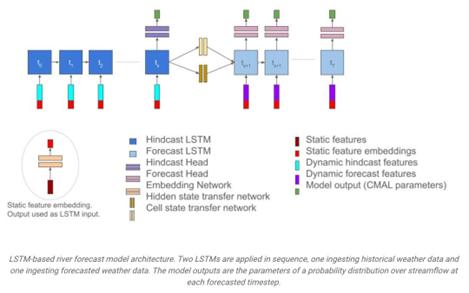A paper published in Nature today shows how Google Research uses AI to accurately predict riverine flooding and help protect livelihoods in over 80 countries up to 7 days in advance, including in data scarce and vulnerable regions.

For most of history, accurate flood forecasting at scale was not possible due to the complexity of the problem and lack of resources and data. Given that only a small percentage of the world’s rivers are equipped with streamflow gauges, this provided an extra barrier to safety for people in developing countries as well as in underserved and vulnerable communities.
In a paper published today in Nature, we share how AI can help scale flood forecasting and bring help to parts of the world that are most impacted by climate change. We found that AI helped us to provide more accurate information on riverine floods up to 7 days in advance. This allowed us to provide flood forecasting in 80 countries in areas where 460 million people live. Where possible, we also provide forecasts in Google Search and Google Maps and via Android notifications.
The paper — described in more detail in our Research blog — demonstrates how AI-based global hydrologic technologies built by Google Research can significantly improve flood forecasting relative to the current state-of-the-art. This is even true for countries where reliable flood-related data is scarce, making it possible to expand flood forecasting on a global scale. Early warning systems can significantly help reduce fatalities, and having more lead time is extremely helpful for communities. With these technologies we extended, on average, the reliability of currently-available global nowcasts from zero to five days, and we were able to use AI-based forecasting to improve forecasts in regions in Africa and Asia to be similar to what are currently available in Europe.
In 2019, we expanded our flood forecasting coverage 12-fold, and sent out 800,000 alerts to individuals in affected areas, while advancing our forecasting technologies.
As our team explored the potential of machine learning to create better flood forecasting models, we also began collaborating with academic researchers to combine the best hydrological physics-based flood simulations with our AI approach.
Based on our research, and the promising development of Long Short-Term Memory networks (LSTMs) to provide accurate flood predictions, we began envisioning a global end-to-end flood forecasting platform that provides trusted and reliable information, even in regions of the world that lack flood gauges.
Flood forecasting further expanded, but was limited by local data availability Following the success of our initial pilot in India, we gradually expanded our forecasts across the country and into Bangladesh, covering 360 million people. At the time, we could provide forecasts up to 48 hours in advance, made possible by significant advancements in our forecasting technology. But in each case, our models relied on the availability of local streamflow data, making it difficult to scale forecasts to additional countries.
The pivot to a global AI-based flood forecasting model and expansion to over 80 countries Recognizing the barriers to flood forecasting when relying on local data, and the advances in AI research, our team pivoted towards an ambitious global model. That required global data sources to train our model on using LSTM networks with the goal of predicting floods even in regions that don’t provide local streamflow measurements.
In 2022, we launched the Flood Hub platform, which provided access to forecasts in 20 countries — including 15 in Africa — where forecasting had previously been severely restricted due to the lack of global data.
A year later, in 2023, we added locations in 60 new countries across Africa, the Asia-Pacific region, Europe, and South and Central America, covering some 460 million people globally. As a result, forecasts are now freely available on the Flood Hub in real time to many vulnerable communities in developing countries. Thanks to advances in our global AI-based model, access to flood forecasting in Africa is now comparable to that of Europe.
Sources:
Military+Aerospace Electronics
https://blog.google/technology/ai/google-ai-global-flood-forecasting/ .
Provided by the IKCEST Disaster Risk Reduction Knowledge Service System
Comment list ( 0 )
